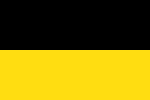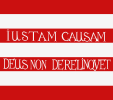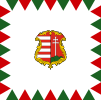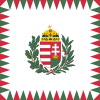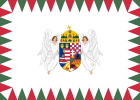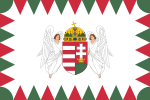Flag of Hungary facts for kids
 |
|
| Use | Civil and state flag |
|---|---|
| Proportion | 1:2 |
| Adopted | 23 May 1957 (as state flag) 19 June 1990 (reaffirmed) |
| Design | A horizontal tricolour of red, white and green |
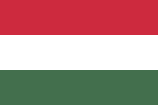
Variant flag of Hungary
|
|
| Use | Civil flag and ensign |
| Proportion | 2:3 |
| Adopted | 18 August 1957 (as civil ensign) |
| Design | A horizontal tricolour of red-white-green |
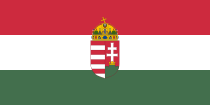
Variant flag of Hungary
|
|
| Use | Unofficial state flag |
| Proportion | 1:2 |
| Adopted | 10 October 1995 |
| Design | A horizontal tricolour of red, white and green with the state coat of arms in the centre. |

Variant flag of Hungary
|
|
| Use | Unit colour |
| Proportion | 6:7 |
| Adopted | 15 March 1991 |
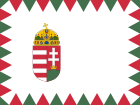
Variant flag of Hungary
|
|
| Use | Naval ensign |
| Proportion | 3:4 |
| Adopted | 1991 |
The national flag of Hungary (Hungarian: Magyarország zászlaja) is a horizontal tricolour of red, white, and green. This means it has three colored stripes going across. This design has been the official flag of Hungary since May 23, 1957.
The flag's design comes from national movements in the 1700s and 1800s. Its colors have been used in Hungary since the Middle Ages. The Hungarian flag is similar to the flag used by republican groups in the United Kingdom in 1816. The colors in this form were seen as early as 1790 during the coronation of Leopold II. This was even before the Italian Tricolour was first used in 1797.
Contents
Hungary's Flag: What It Means
The modern flag of Hungary came from a movement for freedom before 1848. This movement led to the Hungarian Revolution of 1848. The revolution was against the monarchy and the Habsburg Empire. People wanted to create an independent country.
Colors and Their Meaning
The flag has three colors: red, white, and green. These colors come from the historical Hungarian coat of arms. This coat of arms has looked mostly the same since the mid-1400s. The colors were first seen in the late 1100s and early 1200s. They were used by the Árpád dynasty, which was Hungary's first ruling family.
The stripes on the flag go across (horizontally). This helps to avoid confusion with the Italian flag, which has vertical stripes.
People in the past gave special meanings to the colors:
- Red stands for strength.
- White stands for faithfulness.
- Green stands for hope.
Another popular idea is that red means the blood spilled for the country. White means freedom, and green means the land of Hungary. The new Hungarian constitution, which started in 2012, officially states that the colors mean strength, faithfulness, and hope.
How the Flag Changed Over Time
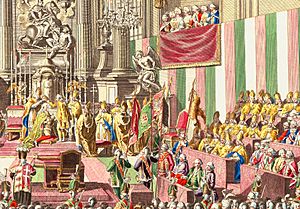
The red, white, and green flag became a symbol of Hungary's independence during the 1848–1849 revolution. This revolution was against the Habsburg rulers. After the revolution was defeated, the tricolour flag was banned by the Austrian Emperor.
However, after a special agreement in 1867, the tricolour flag became legal again. It even became the official flag of Hungary. At this time, the flag sometimes had a small version of the Hungarian coat of arms on it. This version of the flag was used until the Habsburg Empire ended in 1918.
The years after 1918 were very busy and confusing. The red-green-white flag stayed the same, but the small symbol on it changed a few times. For a short time in 1919, Hungary was a Soviet Republic. During this time, they used a plain red flag.
From about 1920 to 1945, the flag usually showed the small Hungarian coat of arms. But sometimes, a plain tricolour flag was also used.
Between 1946 and 1949, the crown was removed from the top of the coat of arms on the flag.
When Communist rule began in 1949, a new coat of arms with a Communist red star was placed on the flag.
During the Hungarian Revolution of 1956 against the Soviet Union, people cut out the Communist symbol from the flag. They used the flag with a hole in the middle as a symbol of their fight for freedom. For a few months, the new government put the small coat of arms (without the crown) back on the flag.
In 1957, after the Soviet army stopped the revolution, the new government created a "new" coat of arms. But this new coat of arms was never officially put on the flag. So, since 1957, the official flag of Hungary has been a simple red-white-green tricolour.
When communism ended in 1989, there was no need to change the flag. Unlike some other countries, Hungary's flag did not have any Communist symbols on it anymore.
Flag Details and Rules
The Hungarian Constitution does not clearly state the exact width-to-length ratio of the flag. However, a law from 1957 says that merchant ships should use a red, white, and green flag with a 2:3 ratio.
A government rule from 2000 states that flags used on government buildings have a 1:2 ratio.
Here are some common ways the flag is used:
 A red–white–green tricolour. People can use this flag to show they belong to the nation.
A red–white–green tricolour. People can use this flag to show they belong to the nation. A red–white–green tricolour with a 1:2 ratio. The official coat of arms of Hungary can be placed on this flag.
A red–white–green tricolour with a 1:2 ratio. The official coat of arms of Hungary can be placed on this flag. A white flag with a border of green and red "flame tongues" (wavy triangles). The coat of arms is in the center, surrounded by oak and olive branches.
A white flag with a border of green and red "flame tongues" (wavy triangles). The coat of arms is in the center, surrounded by oak and olive branches. A 2:3 ratio red-white-green tricolour, used by merchant ships.
A 2:3 ratio red-white-green tricolour, used by merchant ships. A white flag with a border of green and red triangles. The coat of arms is closer to the flagpole.
A white flag with a border of green and red triangles. The coat of arms is closer to the flagpole.
Colors of the Flag
The exact colors of the Hungarian flag are officially defined. Here are the details for each color:
Colors scheme |
Crimson red | White | Dark green |
|---|---|---|---|
| Pantone | 18-1660 TCX Tomato | Not available | 18-6320 TCX Fairway |
| RGB | 206, 41, 57 | 255, 255, 255 | 71, 112, 80 |
| Hexadecimal | #CE2939 | #FFFFFF | #477050 |
Gallery
Historical flags
-
Royal Standard of Hungary under the rule of Béla III (1172–1196).
-
Royal Standard of Hungary under the rule of Sigismund (1387–1437).
-
Royal Standard of Hungary under the rule of Vladislaus I (1440–1444).
-
Royal Standard of Hungary under the rule of Matthias I (1458–1490).
-
Royal Standard attributed to Louis II of Hungary (1516–1526).
-
The flag of the Habsburg dynasty was used in the Kingdom of Hungary from the 18th century to 1848 and between 1849 and 1867.
-
Flag raised during Rákóczi's War of Independence (1703–1711).
-
A variant of the flag of Hungary, used between 1896 and 1915, while part of Austria-Hungary.
-
Flag of Hungary, used between 1946 and 1949 and between 1956 and 1957 with the Kossuth coat of arms.
-
Flag of the Hungarian People's Republic, used between 1949 and 1956, bearing the Communist Rákosi coat of arms.
-
This flag, from which the Rákosi era coat of arms has been cut out, became the symbol of the Hungarian Revolution of 1956.
-
Government ensign of Hungary, used between 1957 and 1990.
Head of state standards
-
Ensign of the Regent, used between 1921 and 1939.
-
Ensign of the President, used between 1948 and 1950.
See also
 In Spanish: Bandera de Hungría para niños
In Spanish: Bandera de Hungría para niños


















